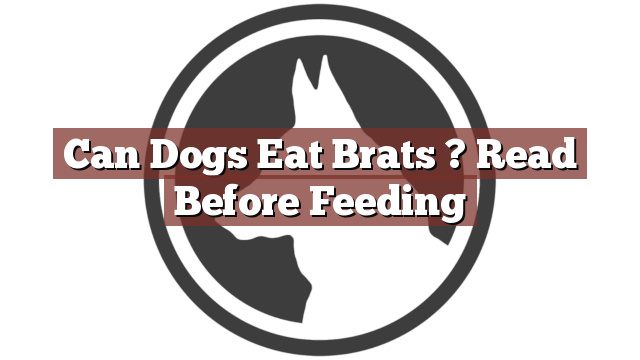Understanding Your Dog’s Dietary Needs
As pet owners, it is our responsibility to ensure that our furry friends are getting a well-balanced and nutritious diet. Understanding your dog’s dietary needs is crucial in keeping them healthy and happy. Dogs are primarily carnivorous, and their diet should consist mainly of animal protein. They require a proper balance of protein, carbohydrates, fats, vitamins, and minerals to thrive. It is important to note that not all human food is suitable or safe for dogs, and it is always best to consult with your veterinarian before introducing new foods into your dog’s diet.
Can Dogs Eat Brats? Read Before Feeding
Can dogs eat brats? This is a common question among dog owners who often enjoy grilling bratwurst during outdoor gatherings. Brats are a type of sausage made from pork, beef, or a combination of both. While brats may be a delicious treat for humans, they are not recommended for dogs.
No, dogs should not eat brats. Brats are typically high in fat, sodium, and seasonings such as garlic and onion, which can be harmful to dogs. Consuming fatty foods can lead to pancreatitis, a condition that causes inflammation in the pancreas. Additionally, the high sodium content in brats can lead to dehydration and other health issues in dogs. The seasonings used in brats, particularly garlic and onion, are toxic to dogs and can cause gastrointestinal upset and even damage their red blood cells.
Pros and Cons of Feeding Brats to Your Dog
It is essential to weigh the pros and cons of feeding brats to your dog before making a decision. One potential benefit of feeding brats to your dog is that they are a good source of protein. However, the high fat content in brats can be detrimental to your dog’s health. Excess fat can contribute to obesity, which can lead to a myriad of health issues such as heart disease, diabetes, and joint problems. Moreover, the seasonings and sodium content in brats can cause adverse reactions and potentially serious health problems for your furry companion.
Conclusion: Proceed with Caution when Feeding Brats to Your Dog
In conclusion, it is best to err on the side of caution when it comes to feeding brats to your dog. While they may enjoy the taste, the potential risks outweigh any potential benefits. It is always important to prioritize your dog’s health and provide them with a balanced and appropriate diet. If you are looking for alternative treats for your dog, there are plenty of healthy options available specifically formulated for canine consumption. Remember, when it comes to your dog’s diet, it’s better to be safe than sorry.
Keywords: can a dog eat brats, can my dog eat bratwurst, feeding brats to dogs, dogs and brats, can dogs have brats.
Thank you for taking the time to read through our exploration of [page_title]. As every dog lover knows, our furry friends have unique dietary needs and responses, often varying from one canine to another. This is why it's paramount to approach any changes in their diet with caution and knowledge.
Before introducing any new treats or making alterations to your dog's diet based on our insights, it's crucial to consult with a veterinarian about [page_title]. Their expertise ensures that the choices you make are well-suited to your particular pet's health and well-being.
Even seemingly harmless foods can sometimes lead to allergic reactions or digestive issues, which is why monitoring your dog after introducing any new food item is essential.
The content provided here on [page_title] is crafted with care, thorough research, and a genuine love for dogs. Nevertheless, it serves as a general guideline and should not be considered a substitute for professional veterinary advice.
Always prioritize the expert insights of your veterinarian, and remember that the health and happiness of your furry companion come first.
May your journey with your pet continue to be filled with joy, love, and safe culinary adventures. Happy reading, and even happier snacking for your canine friend!

